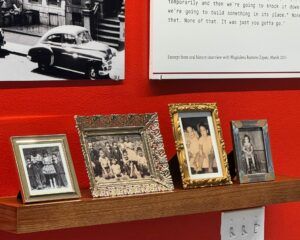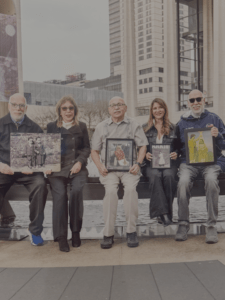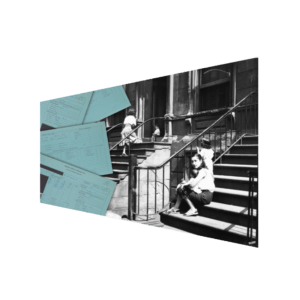Afterlives of San Juan Hill
May 14, 2025 – September 30, 2025
CENTRO en el Barrio
Silberman School of Social Work
2180 3rd Avenue at 119th Street
New York, NY 10035
Engage in a necessary reframing of the scripts that bolstered dispossession in the name of development across New York City in the mid-20th century. By delving into the lived experiences of the community’s residents, Afterlives of San Juan Hill highlights the individual stories of Lincoln Square residents during this pivotal time.
Image: Lincoln Square, 1956. A crowd gathered on a stoop. Image Source Attributed to NYC Parks’ Archived Collection.
About the Exhibition
Though archival records allow us to revisit the past, the way data is collected can create narratives controlled by those in power. Afterlives of San Juan Hill combines data analysis with archival documents, visual storytelling, and oral histories to offer a community centered perspective on a crucial period in US urban history. At the center of this exhibit are the experiences of the Ramírez Zapata family: María Zapata and her four children Gustavo, Magdalena, Harry, and Miguel Ramírez Zapata, one of thousands of families that were displaced in the name of urban development. These histories of dispossession and erasure are as crucial today as they were in the 1950s, and we are honored to illuminate an undertold aspect of New York City history through the lens and stories of those who were directly affected.
Curated by Dr. Cristel M. Jusino Díaz and Christopher López
Curatorial Support and and Research Team: Jorge Soldevila Irizarry, Damayra Figueroa Lazú, Dr. Laura Colón Meléndez, Monique Young, Camila Juarbe, Arianna Meneses, and Maya Borg
Exhibition Production Team: Glorimar García and Sebastián Meltz-Collazo
Graphic Design: Brandon Chacón and Alyssa Chambers
Gallery



Resources

This informational pamphlet dives into the actual data and records of the families who lived in San Juan Hill before it was razed to build Lincoln Center.
Read the pamphlet
CENTRO's Data Hub worked on reviewing over 2,000 archival records from Lincoln Center over the span of 1.5 years.
Learn about the project